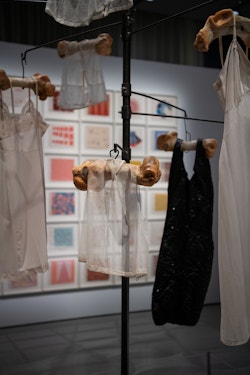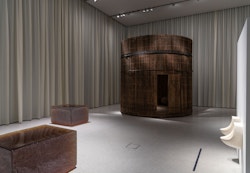Louise Bourgeois
Imaginary Conversations
6 May—6 August 2023
The National Museum, Oslo, Norway
Refusing to be content with a single, fixed expression or to be confined by a single artistic movement, the French-American artist Louise Bourgeois (1911–2010) explored a variety of styles and techniques that few artists can rival. The exhibition "Imaginary Conversations" stages encounters between Bourgeois and other artists. Some of these encounters took place during Bourgeois’s almost century-long life, while others occur across time and space. This is the first major presentation of Bourgeois’s art in Norway in over twenty years.
Works from her entire career are presented, from her paintings and prints from the 1940s to the Cells she created in her final decades. “Imaginary Conversations” also allows you to experience artworks by over fifty other artists, including Edvard Munch, Roni Horn, Pablo Picasso, Alberto Giacometti, Lynda Benglis, Robert Mapplethorpe, Senga Nengudi, Alina Szapocznikow, Seni Awa Camara, Nan Goldin, Robert Gober, and Rosemarie Trockel. Many of the works are being shown in Norway for the first time ever.

Louise Bourgeois was born in France in 1911. After first pursuing mathematics, she became interested in art and studied under artists such as Fernand Léger. In 1938, she married an American art historian and moved to New York. From the 1940s on, she constantly explored new materials and techniques, but it was not until 1982, when Bourgeois was seventy years old, that she achieved recognition thanks to a retrospective exhibition at The Museum of Modern Art in New York.
“Imaginary Conversations” showcases an artist who, throughout her entire career, was preoccupied with the artistic and social changes take place in contemporary life, such as representations of the body in the 1960s, feminism in the 1970s, and the AIDS epidemic of the 1980s and 1990s. Themes such as loneliness, love, disease, sexuality, and gender were concerns Bourgeois shared with many artists. These commonalities serve as the basis for the exhibition’s encounters between Bourgeois and the other artists shown.
Bourgeois was fascinated by architecture which is apparent in early paintings such as the Femme Maison series (1946–47) and self-portraits from the same era, which depict the artist on the roof of a tall building. The Personage series – anthropomorphic carved wood sculptures – was inspired by New York City’s skyscrapers. Many decades later, Bourgeois would explore the house as a symbolic space in the series of installations called Cells. Bourgeois’s Cells resemble theatre stages with the viewer peering in on sculptures, clothes, furniture, and other everyday objects.
During the 1960s and 1970s, many women artists, such as Lynda Benglis, Eva Hesse, Yayoi Kusama, Marisa Merz, Senga Nengudi, and Alina Szapocznikov, explored aspects of the female body that were commonly regarded as inappropriate for public display. Bourgeois pursued similar themes, as seen in her cave-like sculptures made of latex and plaster. The unpolished surfaces resemble something organic or bodily, and at times even look like intestines or excrement.
“Louise Bourgeois. Imaginary Conversations” is co-curated by Senior Curator at the National Museum, Andrea Kroksnes, and visiting curator Briony Fer.
The exhibition is a collaboration with The Easton Foundation and is supported by the DNB Savings Bank Foundation. The National Museum and the DNB Savings Bank Foundation have collaborated for several years on presenting Louise Bourgeois’s art in Norway, including through the long-term deposit of seminal Bourgeois works in the National Museum’s collection.




